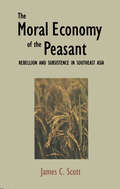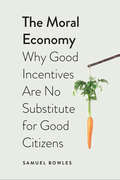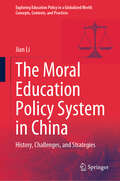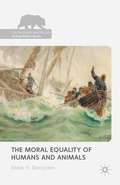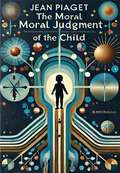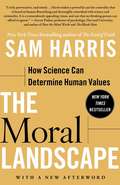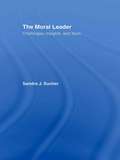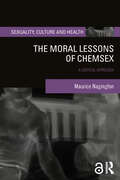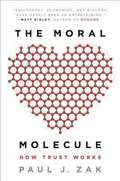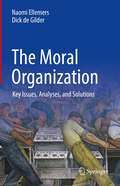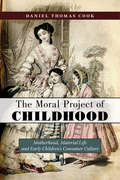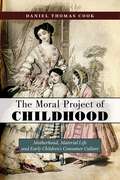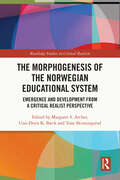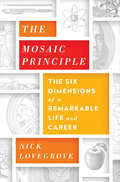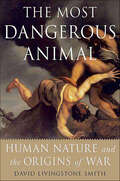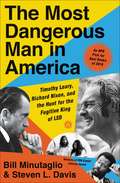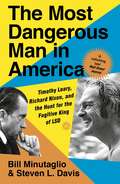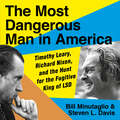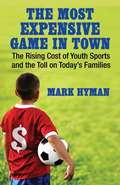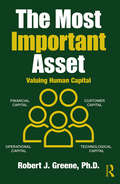- Table View
- List View
The Moral Economy of the Peasant
by James C. ScottJames C. Scott places the critical problem of the peasant household-subsistence-at the center of this study. The fear of food shortages, he argues persuasively, explains many otherwise puzzling technical, social, and moral arrangements in peasant society, such as resistance to innovation, the desire to own land even at some cost in terms of income, relationships with other people, and relationships with institutions, including the state.Once the centrality of the subsistence problem is recognized, its effects on notions of economic and political justice can also be seen. Scott draws from the history of agrarian society in lower Burma and Vietnam to show how the transformations of the colonial era systematically violated the peasants' "moral economy" and created a situation of potential rebellion and revolution.Demonstrating keen insights into the behavior of people in other cultures and a rare ability to generalize soundly from case studies, Scott offers a different perspective on peasant behavior that will be of interest particularly to political scientists, anthropologists, sociologists, and Southeast Asianists."The book is extraordinarily original and valuable and will have a very broad appeal. I think the central thesis is correct and compelling."-Clifford Geertz "In this major work, ... Scott views peasants as political and moral actors defending their values as well as their individual security, making his book vital to an understanding of peasant politics."-Library Journal James C. Scott is professor of political science at Yale University.
The Moral Economy: Why Good Incentives Are No Substitute for Good Citizens
by Samuel BowlesShould the idea of economic man--the amoral and self-interested Homo economicus--determine how we expect people to respond to monetary rewards, punishments, and other incentives? Samuel Bowles answers with a resounding "no. " Policies that follow from this paradigm, he shows, may "crowd out" ethical and generous motives and thus backfire. But incentives per se are not really the culprit. Bowles shows that crowding out occurs when the message conveyed by fines and rewards is that self-interest is expected, that the employer thinks the workforce is lazy, or that the citizen cannot otherwise be trusted to contribute to the public good. Using historical and recent case studies as well as behavioral experiments, Bowles shows how well-designed incentives can crowd in the civic motives on which good governance depends.
The Moral Education Policy System in China: History, Challenges, and Strategies (Exploring Education Policy in a Globalized World: Concepts, Contexts, and Practices)
by Jian LiThis book examines the moral education policy system in China, discussing the challenges of promoting moral education policy in the country, and proposes relative strategies. It explores the moral education policy in China from various perspectives, including in preschool education, primary education, higher education, vocational type-based higher education, secondary vocational education, English education, music education, classroom teaching, citizenship education, and Chinese language education. This book serves as a guide for scholars and researchers who are interested, and work in, research on moral education policy in China, administrators, stakeholders in China's education system, and graduate students who major or minor in the field of moral education policy in China.
The Moral Equality of Humans and Animals (The Palgrave Macmillan Animal Ethics Series)
by Mark H BernsteinReceived opinion has it that humans are morally superior to non-human animals; human interests matter more than the like interests of animals and the value of human lives is alleged to be greater than the value of nonhuman animal lives. Since this belief causes mayhem and murder, its de-mythologizing requires urgent attention.
The Moral Judgment of the Child
by Jean Piaget"The Moral Judgment of the Child" by Jean Piaget is a seminal work in the field of developmental psychology, offering profound insights into how children develop moral reasoning. Piaget, a pioneering psychologist, meticulously examines the stages of moral development from early childhood through adolescence, providing a comprehensive framework for understanding how children distinguish right from wrong.In this influential book, Piaget presents his groundbreaking research based on extensive observations and interviews with children. He explores how children's moral thinking evolves, focusing on the transition from a heteronomous morality, where rules are imposed by authority figures and viewed as unchangeable, to an autonomous morality, where children develop their own sense of justice and fairness based on mutual respect and cooperation.Piaget identifies key factors that influence moral development, such as peer interactions, play, and the child's growing cognitive abilities. He delves into the concepts of intention and consequence, illustrating how children's understanding of these aspects shifts with age and experience. Through detailed case studies and examples, Piaget demonstrates the complexity and variability of moral judgment across different developmental stages."The Moral Judgment of the Child" challenges traditional views of moral development, emphasizing the active role of the child in constructing moral understanding through social interactions and cognitive growth. Piaget's theory has profound implications for education, parenting, and our broader understanding of human development.This book is an essential resource for psychologists, educators, and anyone interested in the intricacies of moral development. Piaget's clear and engaging writing makes complex concepts accessible, while his rigorous research provides a solid foundation for further study. "The Moral Judgment of the Child" remains a cornerstone in developmental psychology, offering timeless insights into the moral lives of children.
The Moral Landscape: How Science Can Determine Human Values
by Sam HarrisNew York Times bestselling author Sam Harris&’s first book, The End of Faith, ignited a worldwide debate about the validity of religion. In the aftermath, Harris discovered that most people—from religious fundamentalists to non-believing scientists—agree on one point: science has nothing to say on the subject of human values. Indeed, our failure to address questions of meaning and morality through science has now become the primary justification for religious faith.In this highly controversial book, Sam Harris seeks to link morality to the rest of human knowledge. Defining morality in terms of human and animal well-being, Harris argues that science can do more than tell how we are; it can, in principle, tell us how we ought to be. In his view, moral relativism is simply false—and comes at an increasing cost to humanity. And the intrusions of religion into the sphere of human values can be finally repelled: for just as there is no such thing as Christian physics or Muslim algebra, there can be no Christian or Muslim morality. Using his expertise in philosophy and neuroscience, along with his experience on the front lines of our “culture wars,” Harris delivers a game-changing book about the future of science and about the real basis of human cooperation.
The Moral Leader: Challenges, Tools and Insights
by Sandra J. SucherSuccessful leaders – at any level and in any arena – are inevitably presented with moral and ethical choices. This unique and innovative textbook is designed to encourage students and managers to confront those fundamental moral challenges, to develop skills in moral analysis and judgment, and to come to terms with their own definition of moral leadership and how it can be translated into action. Drawing on the inspiration of major literary and historical figures such as Machiavelli, Conrad, Shackleton and Achebe, and based upon an impressive array of literary sources, including novels, plays, history and biography, the book centers on four questions implicitly asked of all leaders: What is the nature of a moral challenge? How do people 'reason morally'? How do leaders contend with the moral choices they face? How is moral leadership different from leadership in general? The Moral Leader is based upon the renowned course of the same name taught at Harvard Business School for over two decades. With an emphasis on decision-making and action, students learn to identify moral problems, to address them systematically, and to develop skills that aid them throughout their studies and their professional lives. At times challenging, insightful, and always illuminating, this book is essential reading for all serious students of leadership, management, business ethics or policy. Visit the companion website at www.routledge.com/textbooks/9780415400640
The Moral Lessons of Chemsex: A Critical Approach (Sexuality, Culture and Health)
by Maurice NagingtonThis book explores how gay and bi men’s lived experiences of chemsex intersect with its cultural representations. It argues that while normative moral frameworks are often used to talk about chemsex, chemsex sub-cultures contain their own valuable moral frameworks that can provide lessons about some of the most pressing concerns of contemporary society.Drawing from a tradition of scholarship that views queer sub-cultures as having pedagogical value for all of society, Maurice Nagington critiques norms that govern lives in relation to: the interactions of bodies, sex and capitalism, trauma and tragedy, the regulation of boundaries, and the disciplinary apparatuses in modern society. Each chapter takes its lead from themes informed by the analysis of longitudinal interviews conducted over a two-year period by the author and an archive of materials concerning chemsex such as films, soundtracks, health promotion pamphlets, newspaper articles, blogs, and ethnographic field notes. Linking the accounts of interviewees to wider debates about and representations of chemsex, this innovative book develops a cohesive narrative about the moral lessons chemsex can teach us.Contributing to the emerging field of critical chemsex studies, this volume is of interest to advanced students and scholars interested in gender and sexuality studies, sociology of health and illness, medical anthropology, critical public health and criminology, as well those who are involved in chemsex and wish to read and reflect about it as more than just a problem. The Open Access version of this book, available at http://www.taylorfrancis.com, has been made available under a Creative Commons [Attribution-Non Commercial-No Derivatives (CC-BY-NC-ND)] 4.0 license.
The Moral Molecule: The Source of Love and Prosperity
by Paul J. ZakA Revolution in the Science of Good and EvilWhy do some people give freely while others are cold hearted?Why do some people cheat and steal while others you can trust with your life?Why are some husbands more faithful than others—and why do women tend to be more generous than men?Could they key to moral behavior lie with a single molecule?From the bucolic English countryside to the highlands of Papua New Guinea, from labs in Switzerland to his campus in Souther California, Dr. Paul Zak recounts his extraordinary stories and sets out, for the first time, his revolutionary theory of moral behavior. Accessible and electrifying, The Moral Molecule reveals nothing less than the origins of our most human qualities—empathy, happiness, and the kindness of strangers. .
The Moral Neoliberal: Welfare and Citizenship in Italy
by Andrea MuehlebachMorality is often imagined to be at odds with capitalism and its focus on the bottom line, but in The Moral Neoliberal morality is shown as the opposite: an indispensible tool for capitalist transformation. Set within the shifting landscape of neoliberal welfare reform in the Lombardy region of Italy, Andrea Muehlebach tracks the phenomenal rise of voluntarism in the wake of the state’s withdrawal of social service programs. Using anthropological tools, she shows how socialist volunteers are interpreting their unwaged labor as an expression of social solidarity, with Catholic volunteers thinking of theirs as an expression of charity and love. Such interpretations pave the way for a mass mobilization of an ethical citizenry that is put to work by the state. Visiting several sites across the region, from Milanese high schools to the offices of state social workers to the homes of the needy, Muehlebach mounts a powerful argument that the neoliberal state nurtures selflessness in order to cement some of its most controversial reforms. At the same time, she also shows how the insertion of such an anticapitalist narrative into the heart of neoliberalization can have unintended consequences.
The Moral Organization: Key Issues, Analyses, and Solutions
by Naomi Ellemers Dick de GilderInvestors, customers and employees increasingly expect organizations to take responsibility for the social impact of their activities. This book applies theory and research on moral psychology and social identity, to offer a new perspective on organizational social responsibility and business ethics. The authors use their unique approach to highlight recurring moral challenges in organizational behavior, such as leadership, work motivation, diversity, organizational change and stakeholder relations. Their analysis explains that people are reluctant to acknowledge and confront moral flaws in their workplace behavior, because this constitutes a source of identity threat. Common strategies to cope with this threat invite justifications and symbolic actions – and prevent moral improvement. Each chapter draws together a wealth of research findings and organizational cases. These not only identify and clarify common moral pitfalls, but also show ways to enhance the likelihood that organizations acquire the knowledge, willingness and ability to build an ethical work climate.
The Moral Project of Childhood: Motherhood, Material Life, and Early Children's Consumer Culture
by Daniel Thomas CookExamines the Protestant origins of motherhood and the child consumer Throughout history, the responsibility for children’s moral well-being has fallen into the laps of mothers. In The Moral Project of Childhood, the noted childhood studies scholar Daniel Thomas Cook illustrates how mothers in the nineteenth-century United States meticulously managed their children’s needs and wants, pleasures and pains, through the material world so as to produce the “child” as a moral project. Drawing on a century of religiously-oriented child care advice in women’s periodicals, he examines how children ultimately came to be understood by mothers—and later, by commercial actors—as consumers. From concerns about taste, to forms of discipline and punishment, to play and toys, Cook delves into the social politics of motherhood, historical anxieties about childhood, and early children’s consumer culture. An engaging read, The Moral Project of Childhood provides a rich cultural history of childhood.
The Moral Project of Childhood: Motherhood, Material Life, and Early Children's Consumer Culture
by Daniel Thomas CookExamines the Protestant origins of motherhood and the child consumer Throughout history, the responsibility for children’s moral well-being has fallen into the laps of mothers. In The Moral Project of Childhood, the noted childhood studies scholar Daniel Thomas Cook illustrates how mothers in the nineteenth-century United States meticulously managed their children’s needs and wants, pleasures and pains, through the material world so as to produce the “child” as a moral project. Drawing on a century of religiously-oriented child care advice in women’s periodicals, he examines how children ultimately came to be understood by mothers—and later, by commercial actors—as consumers. From concerns about taste, to forms of discipline and punishment, to play and toys, Cook delves into the social politics of motherhood, historical anxieties about childhood, and early children’s consumer culture. An engaging read, The Moral Project of Childhood provides a rich cultural history of childhood.
The Moral Work of Anthropology: Ethnographic Studies of Anthropologists at Work (Anthropology at Work #2)
by Hanne Overgaard Mogensen Birgitte Gorm HansenLooking at anthropologists at work, this book investigates what kind of morality they perform in their occupations and what the impact of this morality is. The book includes ethnographic studies in four professional arenas: health care, business, management and interdisciplinary research. The discussion is positioned at the intersection of ‘applied or public anthropology’ and ‘the anthropology of ethics’ and analyses the ways in which anthropologists can carry out ‘moral work’ both inside and outside of academia.
The Moral Work of Anthropology: Ethnographic Studies of Anthropologists at Work (Anthropology at Work #2)
by Hanne Overgaard Mogensen Birgitte Gorm HansenLooking at anthropologists at work, this book investigates what kind of morality they perform in their occupations and what the impact of this morality is. The book includes ethnographic studies in four professional arenas: health care, business, management and interdisciplinary research. The discussion is positioned at the intersection of ‘applied or public anthropology’ and ‘the anthropology of ethics’ and analyses the ways in which anthropologists can carry out ‘moral work’ both inside and outside of academia.
The More We Know: NBC News, Educational Innovation, and Learning from Failure
by Eric Klopfer Jason HaasThe rise and fall of iCue: lessons about new media, old media, and education from an NBC-MIT joint venture into interactive learning.In 2006, young people were flocking to MySpace, discovering the joys of watching videos of cute animals on YouTube, and playing online games. Not many of them were watching network news on television; they got most of their information online. So when NBC and MIT launched iCue, an interactive learning venture that combined social networking, online video, and gaming in one multimedia educational site, it was perfectly in tune with the times. iCue was a surefire way for NBC to reach younger viewers and for MIT to test innovative educational methods in the real world. But iCue was a failure: it never developed an audience and was canceled as if it were a sitcom with bad ratings. In The More We Know, Eric Klopfer and Jason Haas, both part of the MIT development team, describe the rise and fall of iCue and what it can teach us about new media, old media, education, and the challenges of innovating in educational media.Klopfer and Haas show that iCue was hampered by, among other things, an educational establishment focused on “teaching to the test,” television producers uncomfortable with participatory media, and confusion about the market. But this is not just a cautionary tale; sometimes more can be learned from an interesting failure than a string of successes. Today's educational technology visionaries (iPads for everyone!) might keep this lesson in mind.
The Morphogenesis of the Norwegian Educational System: Emergence and Development from a Critical Realist Perspective (Routledge Studies in Critical Realism)
by Margaret S. ArcherBased in the philosophy of critical realism, this book employs a range of Margaret Archer’s theoretical concepts to investigate temporal and spatial aspects of Norwegian education. Stemming from Archer’s engagement as visiting professor from 2017 to 2019 in the Department of Education at UiT The Arctic University of Norway, the book explores a new area for critical realist theorizing by asking how different spatial contexts affect the workings of the system. The various chapters employ diverse sets of Archer’s theoretical concepts; from morphogenetic cycles and the emergence of educational systems at the macro level, to the exercise of reflexivity among individual school leaders and students at the micro level. In contrast to the focus on educational homogeneity and similarity among Nordic and Scandinavian countries, and promotion of the conception of the ‘Nordic Model’, this book draws attention to differences between these nations as well as regional differences within Norway. As such, it will appeal to scholars with interests in education, sociology, critical realism, educational sciences and pedagogy, education history and political science as well those with a specific interest in the Nordic region.
The Mortality and Morality of Nations
by Uriel AbulofStanding at the edge of life's abyss, we seek meaningful order. We commonly find this 'symbolic immortality' in religion, civilization, state and nation. What happens, however, when the nation itself appears mortal? The Mortality and Morality of Nations seeks to answer this question, theoretically and empirically. It argues that mortality makes morality, and right makes might; the nation's sense of a looming abyss informs its quest for a higher moral ground, which, if reached, can bolster its vitality. The book investigates nationalism's promise of moral immortality and its limitations via three case studies: French Canadians, Israeli Jews, and Afrikaners. All three have been insecure about the validity of their identity or the viability of their polity, or both. They have sought partial redress in existential self-legitimation: by the nation, of the nation and for the nation's very existence.
The Mosaic Principle: The Six Dimensions of a Remarkable Life and Career
by Nick LovegroveLife-personally and professionally-is lived to the fullest as a mosaic, encompassing a rich and complex set of diverse experiences that provide purpose, meaning, happiness, and success.Yet, the pressures of modern society push us toward narrower focus and deeper specialization in our lives and careers. Our pursuit of specific expertise risks us becoming isolated from those different from us; our lack of shared experience fosters suspicion and conflict. Today we have businesspeople and government officials who persistently distrust and demonize each other; a fortunate swath of society with professional and financial security, increasingly isolated from those left behind; and community leaders who struggle to relate to and connect with the communities they serve. In every walk of life we have allowed ourselves to be pushed into self-defining cocoons from which it is difficult to break out.Nick Lovegrove's compelling vision provides the way out of this contemporary trap. He supplies vivid portraits of those who get it right (such as Paul Farmer, the physician whose broad and imaginative choices bring health and hope to the world's poorest people) and those who get it deeply wrong (such as Jeffrey Skilling, the former CEO of Enron) and connects their experiences with a blueprint of six skills-a moral compass, transferrable skills, contextual intelligence, prepared mind, intellectual thread, and extended network. The Mosaic Principle will help you to succeed in an ever-changing, more complex, and diverse world, and build a more remarkable and fulfilling life.
The Most Dangerous Animal: Human Nature and the Origins of War
by David Livingstone Smith“Original and compelling insights into the human capacity for war . . . A must read for anyone interested in the psychological depths of human nature.” —Barbara S. Held, author of Back to RealityAlmost 200 million human beings, mostly civilians, have died in wars over the last century, and there is no end of slaughter in sight.The Most Dangerous Animal asks what it is about human nature that makes it possible for human beings to regularly slaughter their own kind. It tells the story of why all human beings have the potential to be hideously cruel and destructive to one another. Why are we our own worst enemy? The book shows us that war has been with us—in one form or another—since prehistoric times, and looking at the behavior of our close relatives, the chimpanzees, it argues that a penchant for group violence has been bred into us over millions of years of biological evolution. The Most Dangerous Animal takes the reader on a journey through evolution, history, anthropology, and psychology, showing how and why the human mind has a dual nature: on the one hand, we are ferocious, dangerous animals who regularly commit terrible atrocities against our own kind, on the other, we have a deep aversion to killing, a horror of taking human life.Meticulously researched and far-reaching in scope and with examples taken from ancient and modern history, The Most Dangerous Animal delivers a sobering lesson for an increasingly dangerous world.“Illuminates an exceedingly dark subject: humankind’s deep-seated penchant for war. The result is a discerning, insightful, highly original, and very disturbing book.” —Andrew J. Bacevich, author of The Age of Illusions
The Most Dangerous Man in America: Timothy Leary, Richard Nixon and the Hunt for the Fugitive King of LSD
by Bill Minutaglio Steven L. DavisFrom Bill Minutaglio and Steven L. Davis, authors of the PEN Center USA award-winning Dallas 1963, comes a madcap narrative about Timothy Leary's daring prison escape and run from the law.On the moonlit evening of September 12, 1970, an ex-Harvard professor with a genius I.Q. studies a twelve-foot high fence topped with barbed wire. A few months earlier, Dr. Timothy Leary, the High Priest of LSD, had been running a gleeful campaign for California governor against Ronald Reagan. Now, Leary is six months into a ten-year prison sentence for the crime of possessing two marijuana cigarettes.Aided by the radical Weather Underground, Leary's escape from prison is the counterculture's union of "dope and dynamite," aimed at sparking a revolution and overthrowing the government. Inside the Oval Office, President Richard Nixon drinks his way through sleepless nights as he expands the war in Vietnam and plots to unleash the United States government against his ever-expanding list of domestic enemies. Antiwar demonstrators are massing by the tens of thousands; homemade bombs are exploding everywhere; Black Panther leaders are threatening to burn down the White House; and all the while Nixon obsesses over tracking down Timothy Leary, whom he has branded "the most dangerous man in America."Based on freshly uncovered primary sources and new firsthand interviews, THE MOST DANGEROUS MAN IN AMERICA is an American thriller that takes readers along for the gonzo ride of a lifetime. Spanning twenty-eight months, President Nixon's careening, global manhunt for Dr. Timothy Leary winds its way among homegrown radicals, European aristocrats, a Black Panther outpost in Algeria, an international arms dealer, hash-smuggling hippies from the Brotherhood of Eternal Love, and secret agents on four continents, culminating in one of the trippiest journeys through the American counterculture.
The Most Dangerous Man in America: Timothy Leary, Richard Nixon and the Hunt for the Fugitive King of LSD
by Bill Minutaglio Steven L. Davis'It's a rollicking tale that brings to life the antic atmosphere of America in the 'Me' Decade' Wall Street Journal'A madcap chase... this is a well-written chronicle of 28 months when the world went slightly mad' Sunday Times'A suitably head-spinning account of LSD High Priest Dr Timothy Leary' Mail on SundayOn the moonlit evening of September 12, 1970, an ex-Harvard professor with a genius IQ studies a twelve-foot high fence topped with barbed wire. A few months earlier, Dr. Timothy Leary, the High Priest of LSD, had been running a gleeful campaign for California governor against Ronald Reagan. Now, Leary is six months into a ten-year prison sentence for the crime of possessing two marijuana cigarettes.Aided by the radical Weather Underground, Leary's escape from prison is the counterculture's union of "dope and dynamite," aimed at sparking a revolution and overthrowing the government. Inside the Oval Office, President Richard Nixon drinks his way through sleepless nights as he expands the war in Vietnam and plots to unleash the United States government against his ever-expanding list of domestic enemies. Antiwar demonstrators are massing by the tens of thousands; homemade bombs are exploding everywhere; Black Panther leaders are threatening to burn down the White House; and all the while Nixon obsesses over tracking down Timothy Leary, whom he has branded "the most dangerous man in America."Based on freshly uncovered primary sources and new firsthand interviews, THE MOST DANGEROUS MAN IN AMERICA is an American thriller that takes readers along for the gonzo ride of a lifetime. Spanning twenty-eight months, President Nixon's careening, global manhunt for Dr. Timothy Leary winds its way among homegrown radicals, European aristocrats, a Black Panther outpost in Algeria, an international arms dealer, hash-smuggling hippies from the Brotherhood of Eternal Love, and secret agents on four continents, culminating in one of the trippiest journeys through the American counterculture.
The Most Dangerous Man in America: Timothy Leary, Richard Nixon and the Hunt for the Fugitive King of LSD
by Bill Minutaglio Steven L. Davis'It's a rollicking tale that brings to life the antic atmosphere of America in the 'Me' Decade' Wall Street Journal'A madcap chase... this is a well-written chronicle of 28 months when the world went slightly mad' Sunday TimesFrom Bill Minutaglio and Steven L. Davis, authors of the PEN Center USA award-winning Dallas 1963, comes a madcap narrative about Timothy Leary's daring prison escape and run from the law.On the moonlit evening of September 12, 1970, an ex-Harvard professor with a genius IQ studies a twelve-foot high fence topped with barbed wire. A few months earlier, Dr. Timothy Leary, the High Priest of LSD, had been running a gleeful campaign for California governor against Ronald Reagan. Now, Leary is six months into a ten-year prison sentence for the crime of possessing two marijuana cigarettes.Aided by the radical Weather Underground, Leary's escape from prison is the counterculture's union of "dope and dynamite," aimed at sparking a revolution and overthrowing the government. Inside the Oval Office, President Richard Nixon drinks his way through sleepless nights as he expands the war in Vietnam and plots to unleash the United States government against his ever-expanding list of domestic enemies. Antiwar demonstrators are massing by the tens of thousands; homemade bombs are exploding everywhere; Black Panther leaders are threatening to burn down the White House; and all the while Nixon obsesses over tracking down Timothy Leary, whom he has branded "the most dangerous man in America."Based on freshly uncovered primary sources and new firsthand interviews, THE MOST DANGEROUS MAN IN AMERICA is an American thriller that takes readers along for the gonzo ride of a lifetime. Spanning twenty-eight months, President Nixon's careening, global manhunt for Dr. Timothy Leary winds its way among homegrown radicals, European aristocrats, a Black Panther outpost in Algeria, an international arms dealer, hash-smuggling hippies from the Brotherhood of Eternal Love, and secret agents on four continents, culminating in one of the trippiest journeys through the American counterculture.(P)2018 Hachette Audio
The Most Expensive Game in Town
by Mark HymanNearly 50 million kids play organized sports each year, and each of them has a supportive family that digs deep into its pockets to pay for the essentials-uniforms, equipment, league fees, travel to away games. But the buck doesn’t stop there. With private lessons, elite sports camps, corporate-sponsored tournaments, and all the hotel expenses and tourist traps that come with them, youth sports is more than just a fun pastime. It’s an incredibly profitable market, and it’s become crowded with companies and individuals eager to reap the rewards. Building on his eye-opening investigation into the damaging effects of the ultra-competitive culture of youth sports in his first book,Until It Hurts, sports dad and journalist Mark Hyman takes us behind the scenes for a startling look at the business of youth sports, how it has changed, and how it is affecting young Americans. Examining the youth sports economy from many sides-the major corporations, small entrepreneurs, coaches, parents, and, of course, kids-Hyman probes the reasons for rapid changes in what gets bought and sold in this lucrative marketplace. He takes us to tournaments sponsored by Nike, Gatorade, and other big businesses. He talks to parents who sacrifice their vacations and savings to get their (sometimes reluctant) junior stars to these far-off, expensive venues for a chance to shine. And he introduces us to videos purporting to teach six-month-old babies to kick a ball, to professional athletes who will “coach” an eight-year-old for a hefty fee, to a town that has literally staked its future on preteen sports. However, the story isn’t all big business and bad guys. Hyman also turns the spotlight on individuals cashing in on the youth sports market, but whose goods actually provide (at least) some benefits to kids. Through extensive interviews and original reporting,The Most Expensive Game in Townlooks beyond the high-energy ad campaigns, the supposedly performance-enhancing sneakers, and the cute baby-sized jerseys to explain the causes and effects of the commercialization of youth sports-and to reveal how these changes are distorting and diminishing family life. The proof is in the price tag. Happily, Hyman unearths promising examples of individuals and communities bucking this destructive trend and using youth sports to uplift and enrich kids’ lives, rather than to fill their own pockets.
The Most Important Asset: Valuing Human Capital
by Robert GreeneThe principles of sound human resource management are generally understood, but too often practitioners believe the same policies and programs will work in all contexts. The effectiveness of any system is highly dependent on the context within which it must function. And due to globalization and increased workforce diversity, the contexts across and even within organizations have become more varied.The Most Important Asset is a story about new graduates entering the human resources field, encountering and dealing with workforce management challenges and issues and developing their own professional competence through experience. Principles are presented and alternative solutions to problems are explored, providing the reader with a roadmap for analyzing situations and making decisions as to how to act. Placing the characters in different types of organizations provides insights into how different contexts call for different strategies. Alternative strategies for staffing an organization, developing its people, defining, measuring and rewarding performance are used to illustrate how what is done should be compatible with the mission, culture, organizational strategy, and internal and external realities.
